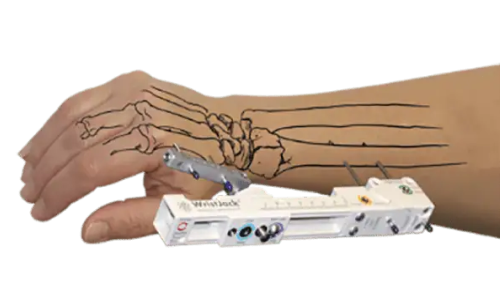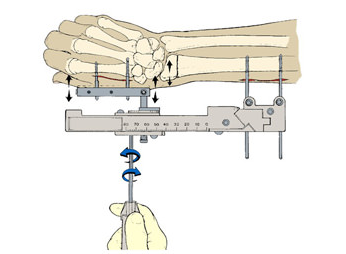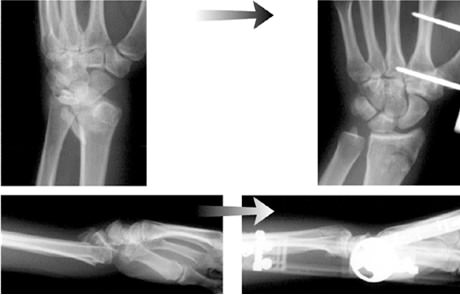
The WristJack Fracture Reduction System was created around the mechanics of the distal radius fracture in order to help physicians obtain the best possible result for their patients. The WristJack uses gear driven adjustments to take advantage of functionally intact soft tissue hinges to achieve ligamentotaxis in multiple planes, or MULTIPLANAR™ Ligamentotaxis.
Palmar translation of the hand on the forearm tightens an intact dorsal periosteum and restores palmar tilt. Radial length, rotational alignment and radial inclination are all independently adjustable using color-coded gears. Wrist positioning is independent from fracture reduction.
Fracture Reduction using the WristJack can be monitored with fluoroscopy.

With the wrist in neutral, length is restored to the distal radius.

Clockwise rotation translates the hand palmarly, aligning the fragment(s) as the periosteum is reapposed. Additional translation of the hand rotates the distal fragment(s) and tilts the articular surface palmarly.


Use of this adjustment “fine-tunes” radial/ulnar alignment. This is important when the fracture extends into the distal radial-ulnar joint.

The wrist can be placed into extension following fracture reduction. Wrist extended position helps avoid finger stiffness and carpal tunnel syndrome.
In order to help ensure the best outcome possible when using the WristJack, it is important for physicians to discuss with their patients why this course of treatment was chosen, the surgical procedure, the length of treatment and any potential complications.

* Not shown
The WristJack Fracture Reduction System was biomechanically designed to complement the fracture patterns of a dorsally displaced distal radius or “Colles” fracture. The device is effective in restoring and maintaining palmar tilt without compromising the hand and median nerve function. Using the incrementally adjustable, color coded gears, the surgeon is able to restore:
Following fracture reduction, the Wrist Lock feature allows the surgeon to place the wrist into an extended position to help prevent finger stiffness and carpal tunnel syndrome.
Click here to watch our surgical technique video that not only shows the proper application of the WristJack, but also discusses the principles of treatment when fixing any distal radius fracture. You can obtain the full DVD by mail through our contact page. A detailed Surgeon’s Manual is included inside every WristJack sold or can be downloaded from this website.
First, length is restored to the radius by using the RED worm gear adjustment. Moving to the GREEN adjustment, the hand is palmarly translated on the forearm. As the dorsal soft tissues tighten, they first bring the distal fragment(s) into opposition with the shaft of the radius. With further palmar translation of the hand, the articular surface tilts back towards normal.

Further correction of the fracture anatomy can be “dialed in” using the other incremental adjustments.
Longitudinal traction alone is usually not able to restore volar tilt to the distal radius unless combined with advanced degrees of wrist flexion. When extreme wrist flexion is used to maintain palmar tilt, it predisposes the patient to carpal tunnel syndrome and finger stiffness.
The WristJack avoids wrist flexion and instead uses palmar translation of the hand. Restoration of length to the radius tightens the dorsal soft tissue hinge. The hand is then palmarly translated on the forearm. This palmar translation transmits a rotatory force from the hand through the carpus to the distal fragment(s) of the radius and tilts the articular surface back towards normal.
The unique biomechanical design of the WristJack complements the fracture patterns of a dorsally displaced distal radius fracture. The device is installed on pins placed in the hand and forearm after gentle manipulation obtains gross alignment of the fracture. Reduction is then accomplished through selective incremental adjustment of the gear mechanisms. Changing the alignment in one plane does not jeopardize previously obtained reductions in the other planes. Incremental adjustment mechanisms drive the fragments in orthogonal planes making it easy to understand the effects of each adjustment. Pin locations minimize soft tissue injury and maximize fracture reducibility.
In addition, post-operative adjustments and removal can be done in the office setting.
Yes. WristJack is sold as a single use, STERILE kit.
Yes, please see X-rays below that illustrate this point. Note the X-rays show that the wrist and fracture site are not over-distracted and yet fracture reduction is maintained. Follow-up X-rays need to be taken a week after surgery to reassess fracture reduction, including distraction and palmar translation forces.

THERAPISTS
The WristJack Fracture Reduction System was biomechanically designed to complement the fracture patterns of a dorsally displaced distal radius or “Colles” fracture. The device is effective in restoring and maintaining palmar tilt without compromising the hand and median nerve function. Using the incrementally adjustable, color coded gears, the surgeon is able to restore:
Following fracture reduction, the Wrist Lock feature allows the surgeon to place the wrist into an extended position to help prevent finger stiffness and carpal tunnel syndrome.
Yes, please see X-rays below that illustrate this point. Note the X-rays show that the wrist and fracture site are not over-distracted and yet fracture reduction is maintained. Follow-up X-rays need to be taken a week after surgery to reassess fracture reduction, including distraction and palmar translation forces.

 Further correction of the fracture anatomy can be “dialed in” using the other incremental adjustments.
Further correction of the fracture anatomy can be “dialed in” using the other incremental adjustments.Patients
The WristJack Fracture Reduction System was biomechanically designed to complement the fracture patterns of a dorsally displaced distal radius or “Colles” fracture. The device is effective in restoring and maintaining palmar tilt without compromising the hand and median nerve function. Using the incrementally adjustable, color coded gears, the surgeon is able to restore:
Following fracture reduction, the Wrist Lock feature allows the surgeon to place the wrist into an extended position to help prevent finger stiffness and carpal tunnel syndrome.
BUYERS
Yes. WristJack is sold as a single use, STERILE kit.
Care must be taken to bill each patient correctly. Click here for downloadable billing guidelines.
© Hand Biomechanics Lab, Inc.